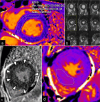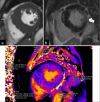Cardiac magnetic resonance imaging in Fabry disease
- PMID: 40709293
- PMCID: PMC12289101
- DOI: 10.25259/JCIS_155_2024
Cardiac magnetic resonance imaging in Fabry disease
Abstract
Fabry disease (FD) is a rare X-linked lysosomal storage disorder. Cardiac involvement is frequent in the classic phenotype and late-onset cardiac variant of FD. It is challenging to distinguish FD cardiomyopathy from other forms of unexplained left ventricular hypertrophy, especially in those patients without extracardiac manifestations. Cardiac magnetic resonance imaging is an essential imaging modality for the quantitative and qualitative assessment of FD cardiomyopathy. It helps to monitor disease progress and allows early disease detection in the mild form or subclinical cardiac phenotypes. This review illustrates the characteristic imaging features of FD cardiomyopathy in cardiac MRI, aiming to enhance the awareness of this disease entity among the scope of unexplained cardiomyopathy and promote timely enzyme replacement therapy for patients.
Keywords: Cardiac magnetic resonance imaging; Fabry disease; Hypertrophic cardiomyopathy.
© 2025 Published by Scientific Scholar on behalf of Journal of Clinical Imaging Science.
Conflict of interest statement
There are no conflicts of interest.
Figures








Similar articles
-
Left Ventricular Hemodynamic Forces Changes in Fabry Disease: A Cardiac Magnetic Resonance Study.J Magn Reson Imaging. 2025 Jul;62(1):116-127. doi: 10.1002/jmri.29700. Epub 2025 Jan 22. J Magn Reson Imaging. 2025. PMID: 39843855
-
Automated electronic health record-based screening for Fabry disease in unexplained left ventricular hypertrophy (FAPREV-HCM).Open Heart. 2025 Jan 11;12(1):e003116. doi: 10.1136/openhrt-2024-003116. Open Heart. 2025. PMID: 39800432 Free PMC article. Clinical Trial.
-
Genetics, cardiac phenotype and cardiovascular outcomes in Fabry disease patients in Finland.ESC Heart Fail. 2025 Jul 21. doi: 10.1002/ehf2.15387. Online ahead of print. ESC Heart Fail. 2025. PMID: 40692291
-
Influence of Treatment Effect Modifiers in Fabry Disease: A Systematic Literature Review.Adv Ther. 2025 Feb;42(2):579-596. doi: 10.1007/s12325-024-03062-x. Epub 2024 Dec 5. Adv Ther. 2025. PMID: 39636566 Free PMC article.
-
The use and performance of lyso-Gb3 for the diagnosis and monitoring of Fabry disease: A systematic literature review.Mol Genet Metab. 2025 Jun;145(2):109110. doi: 10.1016/j.ymgme.2025.109110. Epub 2025 Apr 21. Mol Genet Metab. 2025. PMID: 40328031
References
-
- Linhart A, Arad M, Elliott PM, Caforio ALP, Pantazis A, Adler Y. ESC Working Group Myocardial and Pericardial Diseases. Diagnosis and management of cardiac manifestations in Anderson Fabry disease and glycogen storage diseases. Available from: https://www.escardio.org/static-file/escardio/subspecialty/working%20gro... [Last accessed on 2025 Apr 28]
LinkOut - more resources
Full Text Sources
